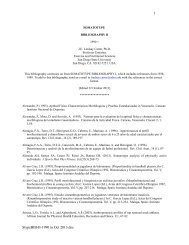THE HEATH-CARTER ANTHROPOMETRIC ... - Somatotype.org
THE HEATH-CARTER ANTHROPOMETRIC ... - Somatotype.org
THE HEATH-CARTER ANTHROPOMETRIC ... - Somatotype.org
Create successful ePaper yourself
Turn your PDF publications into a flip-book with our unique Google optimized e-Paper software.
<strong>Somatotype</strong> Instruction Manual 7<br />
The equation to calculate mesomorphy is:<br />
mesomorphy = 0.858 x humerus breadth + 0.601 x femur breadth + 0.188 x corrected arm<br />
girth + 0.161 x corrected calf girth – height 0.131 + 4.5.<br />
Three different equations are used to calculate ectomorphy according to the height-weight<br />
ratio:<br />
If HWR is greater than or equal to 40.75 then<br />
ectomorphy = 0.732 HWR - 28.58<br />
If HWR is less than 40.75 but greater than 38.25 then<br />
ectomorphy = 0.463 HWR - 17.63<br />
If HWR is equal to or less than 38.25 then<br />
ectomorphy = 0.1<br />
For subjects 573 and B-188 respectively (Figures 1, 2), the resulting somatotypes (using height<br />
corrected endomorphy) are 1.6-5.4-3.2, and 3.0-2.1-4.8,<br />
The preceding equations, derived from data used by Heath and Carter (1967), use metric units.<br />
The equation for endomorphy is a third degree polynomial. The equations for mesomorphy and<br />
ectomorphy are linear. (When the HWR is below 40.75 a different equation is used for ectomorphy.) If<br />
the equation calculation for any component is zero or negative, a value of 0.1 is assigned as the<br />
component rating, because by definition ratings cannot be zero or negative.<br />
Checking the results<br />
Now that the anthropometric somatotype has been calculated, is the result logical? There are<br />
several ways to check your results for measurement or calculation errors.<br />
Using the rating form examples in Figures 1 and 2, the resulting somatotypes rounded to the<br />
nearest half-unit, are 1½-5½-3 and 3-2-5 for subjects 573 and B-188 respectively. Are these<br />
reasonable somatotypes? Certain somatotype ratings are not biologically possible, although our<br />
examples are not among them. For example, a 2-2-2 or a 7-8-7 are impossible somatotypes.<br />
Generally, somatotypes high in endomorphy and/or mesomorphy cannot also be high in ectomorphy.<br />
Conversely, those high in ectomorphy cannot be high in endomorphy and/or mesomorphy; and those<br />
low in endomorphy and mesomorphy must be high in ectomorphy.<br />
Next, look at the pattern of circled values in the endomorphy and mesomorphy sections of the<br />
rating form. Are there inconsistencies in the data? For endomorphy, are the skinfold values<br />
reasonable? For mesomorphy, is there one measure (excluding height) that is quite far apart from the<br />
others? In Figure 1, upper limb circled values are slightly to the right of, and larger relative to height,<br />
than the lower limb measures. However, this pattern is not unusual and is quite acceptable in this case.<br />
On the other hand, if the femur width was 7.95 cm instead of 9.75 cm, or corrected calf girth was 44.9<br />
cm instead of 37.1 cm, such large deviations would suggest errors. Check for errors in recording and<br />
remeasure the subject if possible. Also, check to see that the correct skinfolds in cm have been<br />
subtracted for the corrected girth values. In Figure 2, the small corrected biceps girth (23.4 cm) looks<br />
suspiciously low, but in this subject it truly represented her small muscular development in the upper<br />
limb.




